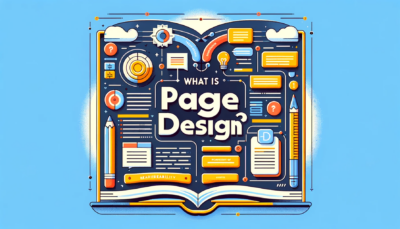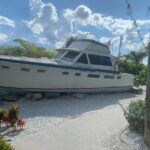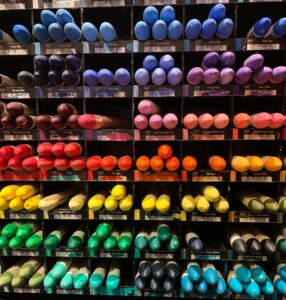
What is Design?
Design, most conventionally, refers to how something looks or works. For instance, by any measure, the Apple iPhone is well designed: the colors it displays are brilliant; it fits in your pocket; it’s easy to use as a camera, a recording device, or phone; and it provides easy access to friends, music, and the internet.
Yet, design may refer to more than whether or not a text or product looks good or accomplishes its aims. For instance, design may also be defined as
- a social construct
- a form of visual language, a mode of human communication
- a signifier of identity and community
- a subject of study, an academic discipline, a catechism regarding usr, an interpretative framework, based on principles of design.
Definitions of Design
1. Design Refers to How a Text, Application, or Product Looks or Works
“Design is a fun word. Some people think design means how it looks.
Steve Jobs
But of course, if you dig deeper, it’s really how it works.”
Design refers to the aesthetics and functionality of a text, application, or product—concepts often encapsulated under the banner of “look and feel.”
Aesthetics (Look):
This dimension of design involves the visual, tactile, and sometimes auditory elements of a product or system. It encompasses attributes such as color, shape, texture, typography, and layout. In terms of a digital application, for example, the choice of icons, the color scheme, typography, and the overall user interface (UI) fall under aesthetic considerations. These elements contribute to the overall visual appeal and user experience.
Functionality (Works):
This refers to the operational aspect of a design. It involves how well the product, application, or system serves its intended purpose. The functionality of a design is often evaluated based on its efficiency, effectiveness, and ease of use. In the case of a digital application, it would include aspects like navigation flow, load times, responsiveness, and overall usability.
In essence, the balance between aesthetics and functionality is key in design. A design that excels in both dimensions creates an engaging, user-friendly, and effective product or system. This outlook is crucial in fields like product design, web design, graphic design, and user experience (UX) design, among others.
For writers, design largely concerns
- the visual appeal of a text
- the use of data visualizations and other elements of design and visual language
- the usability of a text
- the page design & scannability of a text.
2. Design is a Social, Historical Construct
Design, a social and historical construct, stands at the intersection of art, culture, history, and technology. It serves as a mirror to our collective intellect, reflecting our beliefs, history, and advancements. Each culture, each epoch has its unique interpretation and manifestation of design, thus weaving a rich, multifaceted tapestry of human creativity and evolution.
Art and Culture
Art and cultural norms seep deep into the core of design, infusing it with distinctive colors and patterns. Take, for example, the traditional Mexican design. Its bright geometric patterns symbolize the nation’s vibrant culture and rich historical narratives. It’s a testament to the cultural sensibilities that pervade design.
But look closer, and you see a paradox: despite periods of hardship and scarcity, Mexican people devoted resources to create opulent gold temples and intricate religious artifacts for the Catholic Church. This underscores design’s role as a reflection of cultural priorities and beliefs, sometimes extending beyond immediate practical needs.
History
Design reflects the dialogues, epistemologies, and circumstances of particular cultures and specific time periods. Consider, e.g., in the heart of the desert, the ancient Egyptians designed pyramids and temples that continue to astound us millennia later. These structures, built with an extraordinary precision that baffles modern engineers, stand as a testament to the design sensibilities of a civilization that existed over 4,000 years ago. Their hieroglyphic scripts and symbolic art formed a design language that communicated spiritual beliefs and pharaonic authority.
Fast forward to the Victorian era, characterized by its industrial growth and prosperity, and you see a markedly different design narrative. The Victorian designs embraced opulence and ornamentation, with an emphasis on detailing and a penchant for grandeur. This was reflected in their architecture, fashion, and even their typography.
In stark contrast, the 21st century has been marked by a shift towards minimalism in design. Embodying the mantra ‘less is more,’ modern design trends advocate simplicity and functionality. From the sleek lines of contemporary architecture to the user-friendly design of digital interfaces, the present-day design ethos emphasizes usability and clarity.
3. Design is a Form of Visual Language
Design refers to much more than how something looks or works. Design, at its core, is a sophisticated form of visual language. More than just aesthetically pleasing arrangements of elements, it holds the power to communicate, provoke thought, and stir emotions.
This communication occurs at a fundamental, prelinguistic level–as a form of felt sense. While conventional languages use words and syntax to convey meaning, design communicates through a rich vocabulary of visual elements: lines, shapes, colors, spaces, and typography. These elements are arranged using principles like alignment, balance, and contrast to create a cohesive visual message.
When the audience interacts with a design, they are not just passively observing. They are actively ‘reading’ these visual elements and interpreting them. This interpretation often happens instinctively, tapping into our innate human capacity for visual perception. We are, as a species, highly attuned to visual information. Our brains are wired to recognize patterns, discern contrasts, and respond to visual stimuli.
Audiences read the design of a text or product just as they read words and sentences. Yet rather than words or sentences, they read design elements: They trace the line on the page or screen. They note the images, colors, shapes, contrast, spaces, and typography of the copy. They consider the alignment, balance, proximity, repetition of symbols. And then they interpret these symbolic elements to mean something. Their interpretation may be experienced as a form of felt sense of gestalt. In other words, they engage in acts of communication.
4. Design May Function as a Signifier of Identity and Community
In business, companies spend small fortunes defining their brand. They aim to distinguish their products and services. Thus, it’s fairly commonplace for business and nonprofit organizations to have style guidelines.
Typically style guidelines
- call for standard written English
- call for a professional writing style
- call for a particular citation style
- define logo, color, and photo-usage guidelines.
5. Design May Refer to a Curriculum, a Catechism, a Subject of Study
Design is an extraordinarily broad field, a convergence point where disciplines such as arts, engineering, sciences, and humanities intersect and engage in a dynamic discourse. Its interdisciplinary nature stems from the fact that design problems often require diverse perspectives and multi-faceted solutions. Hence, design isn’t just about aesthetics or usability; it’s about crafting solutions that reconcile functionality, sustainability, social impact, and user experience.
In academic settings, design manifests as a robust field of study, encompassing a broad spectrum of topics, including
- accommodation s(how designs cater to different user needs)
- aesthetics (the principles that guide visual harmony and appeal)
- information architecture (how information is organized and structured in a design),
- information design (how information is presented)
- usability (how user-friendly a design is).
Communities of Practice: Shaping the Design Landscape
Alongside academia, communities of practice contribute significantly to the evolution of design as a field. These communities, composed of practitioners and scholars, engage in rigorous scholarship and empirical research. Their primary objective is to enhance clarity in communication and improve design outcomes.
These communities continually shape the design landscape through the development of conventions and best practices. They respond dynamically to technological advancements and societal shifts, adapting design practices to better fit new paradigms. This iterative process of exploration, adaptation, and refinement is what keeps design relevant and effective in a rapidly changing world.
Through this ongoing conversation of humankind and the ever-evolving technological landscape, design continues to evolve, offering innovative solutions to both old and new problems. This is a testament to design’s versatile nature and its inherent capacity to adapt, innovate, and inspire.
Related Concepts
Writers, designers, and usability experts design texts and products by composing with design elements (e.g., Color – Color Theory; Line; Shape; Space; Typography). Additionally, they consult their knowledge of design principles — (e.g., alignment; balance; color; Contrast; Emphasis; Gestalt, Gestalt Theory; Proximity; Repetition) in order to inform their compositions.
Recommended Books on Design
- Cooper, A., Reimann, R., Cronin, D., & Noessel, C. (2014). About face: The essentials of interaction design (4th ed.). Wiley.
- Krug, S. (2013). Don’t make me think, revisited: A common sense approach to web usability (3rd ed.). New Riders.
- Norman, D. (2013). The design of everyday things: Revised and expanded edition. Basic Books.
- Williams, R. (2014). Non-designer’s design book (4th ed.). Peachpit Press.
FAQs
Why does design matter?
In 2023, we’re living in a world where attention spans are shrinking, digital content is proliferating, and consumer expectations are escalating. The average person spent around 6 hours and 42 minutes online every day, and this time is scattered across various platforms – social media, news sites, video streaming, online shopping, and much more. The explosion of digital content means people are inundated with information, choices, and distractions, making it harder than ever to stand out. In this context, excellent design isn’t just nice to have – it’s a necessary tool for survival. It’s a way to respect your audience’s time, to reward their attention, and to rise above the noise.












